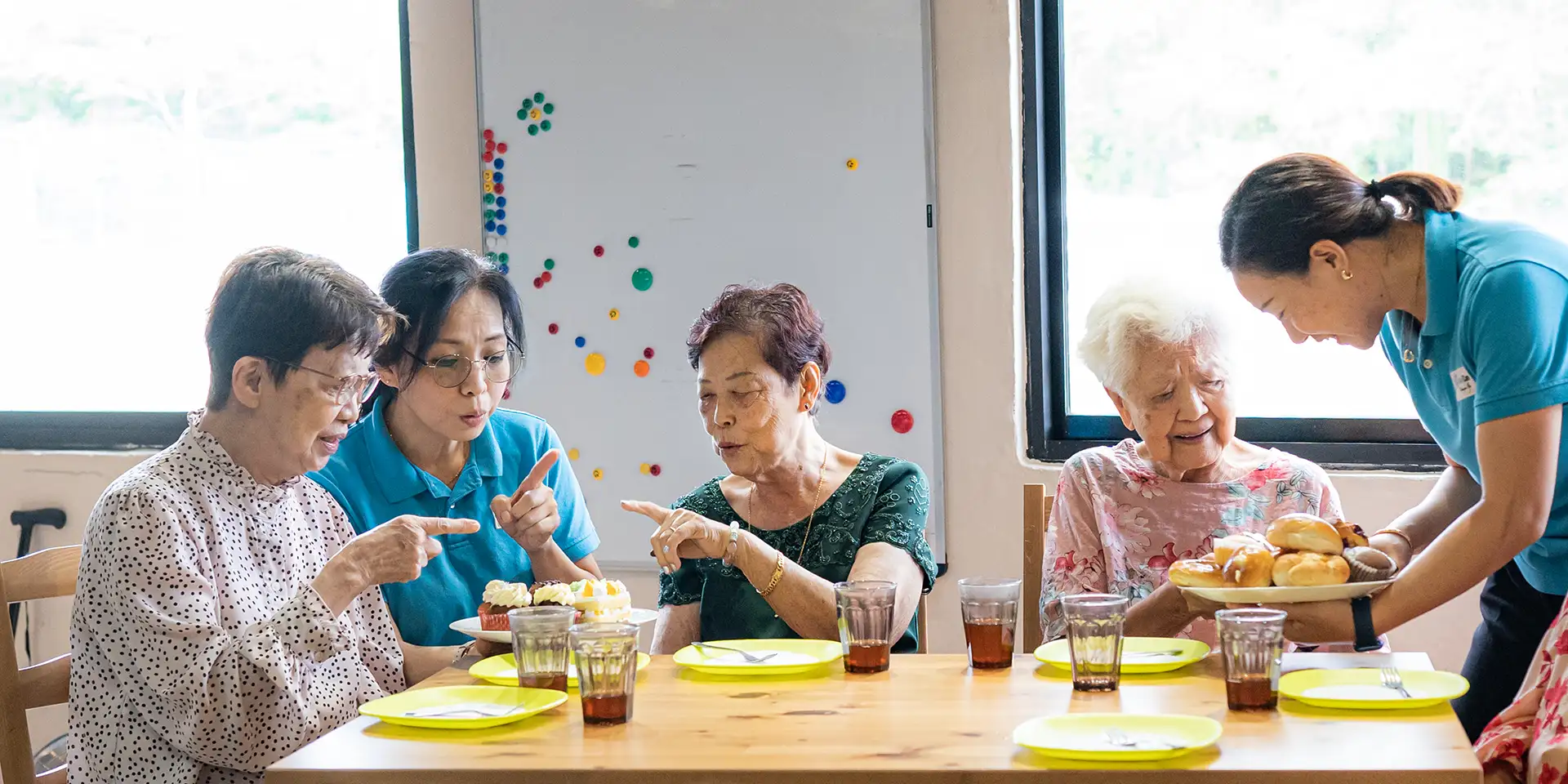Have you ever noticed how the aroma of a familiar dish can instantly transport you back to childhood? That magical connection between food and memory is particularly powerful for seniors, especially those living with cognitive changes. The flavours, smells, and textures of traditional dishes don’t just satisfy hunger—they unlock treasured memories and personal histories. At Hovi Club, our senior day care centre, we’ve observed how culinary experiences create powerful pathways for reminiscence, particularly among our members with connections to Singapore’s rich food heritage.
Understanding the power of food memories in senior care
Food-related memories are remarkably resilient, often remaining accessible even when other recollections have faded. Why? Because culinary experiences engage multiple senses simultaneously—taste, smell, touch, sight, and sometimes even sound—creating robust neural pathways that strengthen memory formation and recall.
For seniors attending Hovi Club’s day rehabilitation programmes, food-based reminiscence activities offer more than just enjoyment. These experiences stimulate cognitive function, encourage social interaction, and provide emotional comfort through familiar sensory experiences. When we incorporate traditional cooking demonstrations or food tastings into our activities, we observe increased engagement and animated sharing of personal stories.
Food is our common ground, a universal experience that connects generations and cultures. Through traditional dishes, we can access memories that might otherwise remain locked away.
What is culinary heritage and why is it important for reminiscence?
Culinary heritage encompasses the recipes, cooking techniques, ingredients, traditions, and stories related to food that have been passed down through generations. It’s more than just cooking—it’s a living museum of cultural identity and family history.
For seniors, especially those living with memory challenges, culinary heritage offers a remarkably effective reminiscence pathway. The brain’s olfactory bulb, which processes smells, connects directly to areas responsible for memory and emotion. This explains why food aromas can trigger such powerful emotional responses and detailed recollections.
At Hovi Club, we integrate elements of culinary heritage into our social interaction programmes and cognitive rehabilitation activities. We find that even when verbal communication becomes challenging, the sensory experiences of familiar foods can still evoke meaningful responses and connections.
Exploring Joo Chiat’s unique food landscape
Joo Chiat, one of Singapore’s most culturally rich neighbourhoods, provides a fascinating case study in culinary heritage. Originally a coconut plantation, this area evolved into a vibrant community where Peranakan, Malay, Chinese, and Eurasian influences merged to create a distinctive food identity.
The neighbourhood’s colourful shophouses now house traditional bakeries, spice merchants, and family-run eateries that have preserved cooking methods across generations. Many of our Hovi Club members who grew up in or around Joo Chiat light up when discussing the area’s food culture, sharing detailed memories of market visits and family meals that might otherwise remain dormant.
Traditional cooking methods that evoke powerful memories
The distinctive techniques used in Joo Chiat’s culinary traditions create powerful sensory triggers for reminiscence. The wok hei (breath of the wok) in Chinese cooking produces distinctive aromas that many seniors immediately recognise. Similarly, the rhythmic pounding of spices for Peranakan dishes or the patient hand-kneading of dough for traditional kueh evoke procedural memories—the body remembering familiar movements before the mind consciously recalls them.
For people living with dementia, these procedural memories often remain intact longer than declarative memories. At Hovi Club, we’ve found that demonstrating these cooking techniques in our cognitive training sessions can unlock stories and recollections that surprise even family members.
Iconic Joo Chiat dishes and their sensory memory connections
Certain signature dishes from Joo Chiat carry particularly strong memory associations. Katong laksa, with its distinctive fragrant coconut broth and thick rice noodles, often triggers detailed recollections about family outings or rainy day comforts. Traditional Peranakan kueh, with their vibrant colours and complex textures, frequently prompt stories about festive celebrations and family gatherings.
These culinary landmarks serve as effective memory anchors, helping seniors orient themselves both geographically and temporally through familiar tastes and aromas. The sensory richness of these foods—combining visual appeal, distinctive textures, complex flavours, and evocative aromas—creates multiple pathways for memory retrieval.
How do tastes and aromas unlock personal histories?
The science behind food’s remarkable memory-evoking power lies in our neurological wiring. Taste and smell signals travel directly to the brain’s limbic system, bypassing the thalamus (which filters other sensory information). This direct pathway explains why food memories can feel so immediate and emotionally charged.
This phenomenon, sometimes called the Proust effect after the author’s famous madeleine cookie memory, has particular significance for memory care. When cognitive barriers make accessing memories difficult, the sensory pathways activated by familiar foods can create alternative routes to personal histories and emotional connections.
Implementing culinary reminiscence in care practices
At Hovi Club, we incorporate culinary heritage into our rehabilitation programmes through several approaches:
- Food-themed reminiscence sessions featuring traditional snacks and drinks
- Cooking demonstrations that showcase traditional techniques
- Simple food preparation activities adapted for various ability levels
- Themed celebrations highlighting cultural food traditions
We find that combining these activities with our broader social, physical, and cognitive rehabilitation programmes creates powerful opportunities for connection and engagement. Family members are encouraged to share favourite recipes or food traditions, which our activity coordinators can incorporate into personalised care approaches.
The journey through culinary heritage offers a rich, multisensory path to meaningful engagement with seniors, particularly those experiencing memory challenges. By honouring the food traditions of communities like Joo Chiat, we not only preserve cultural knowledge but also create valuable opportunities for seniors to reconnect with their personal histories and share their wisdom across generations.

